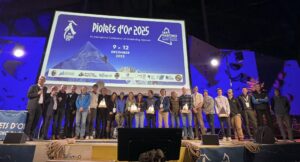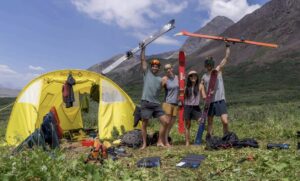This year’s Piolets d’Or awards have gone to new routes on Pakistan’s Pumari Chhish East, Nepal’s Jugal Spire, and Peru’s Jirishanca, climbed by French, British and Canadian teams respectively. There is also a special mention of a new route on Greenland’s Sun Spire by an international female team on an expedition with a low carbon footprint.
Pumari Chhish East and Jugal Spire, both first ascents, were also selected among the best expeditions of 2022 by ExplorersWeb. Berg and Roberts’ route on Jirishanca in Peru came as a pleasant surprise.
Jirishanca (ca. 6,094m), south-southeast spur
Canadians Alik Berg and Quentin Roberts completed the first ascent of the SSE spur of Jirishanca, one of the highest peaks of the Huayuash range in Peru. They named their 1,000m, M7 AI5+ 90° route Reino Hongo (Mushroom Kingdom).
The line has all the typical features of high-level Andean climbing: unknown terrain, snow and ice mushrooms, and ice-plastered, vertical walls. The pair climbed the SSE spur in excellent style: on-sight, in a single push, and carrying everything with them.

The ‘Reino Hongo’ route, overlaid on a photo of Jirishanca by Quentin Roberts. Photo shared by the Piolets d’Or
[The pair] climbed five or so pitches up the lower spur and then wrapped around the steeper section above onto the south flank. Here, they climbed steep mixed terrain to regain the spur below the convoluted snow/ice ridge shaped like a dragon’s back. They completed this section on day one, the ridge itself on day two, and the crux headwall on day three. The latter provided unprotected pitches that were sometimes as difficult and potentially as dangerous for the second as the leader.
Although Jirishanca is rarely climbed, Berg and Roberts met another team (from the U.S.) on the summit. They used their route (via the east buttress and lower southeast face) to descend, which took one more bivy night.
Jury members felt this was “an inspiring line, direct to the summit, and climbed in exactly the style and with the spirit of adventure that the Piolets d’Or wishes to promote.”
Pumari Chhish East (ca. 6,850m)
Christophe Ogier, Victor Saucede, and Jerome Sullivan of France succeeded on their (sixth overall) attempt on the eastern and most technical point of the Pumari Chhish group, north of the Hispar Glacier. Their route, which they dubbed The Crystal Ship, is 1,600m long and goes up the south face and upper west ridge. The team graded it as 6b A2 M7.
The team started by enduring 26 straight days of bad weather. The moment an optimistic weather report came, they hurried across the snowfield at the base of the peak during the night and started up.

Route map of the Crystal Ship on Pumari Chhish East. Photo: Victor Saucede/Piolets d’Or
On the 700m pillar, they employed big-wall techniques, with the leader hauling while the two seconds jumared. Aid was often used to surmount overhangs or to remove large snow formations plastered onto the cracks. Generally, they climbed as free as possible under the conditions. The first three bivouacs were poor, exposed, and uncomfortable, but the fourth day took them through the remaining difficulties, which included two vertical 6b rock pitches at 6,600m (led in rock shoes), to a relatively spacious shoulder. The next day, they climbed through the summit mushroom and were on top at 10 am.
The climbers then waited in their bivy spot for the sun to disappear from the face before rappelling down in the afternoon. They made it back to Base Camp by midnight.
“[It is] an elegant line…full of uncertainty, on one of Pakistan’s big unsolved problems,” the jury declared. “It is not the easiest option on the mountain, but the steepness and sustained high level of difficulty made it one of the safest, rising almost directly to the summit. The ascent was very much a collective effort, displaying great team spirit.”
Jugal Spire (aka Dorje Lhakpa II, 6,563m)
The UK’s Paul Ramsden had spent the COVID lockdown looking for a peak to climb in the future. When the opportunity came, he traveled to Nepal with young Tim Miller to attempt the rocky north face of unclimbed Jugal Spire. Almost rocky, to be accurate. A thin line of ice crossed at least part of the face. A big section was hidden, and there was no way to know if the ice line had a continuation. They went for it, anyway.

The ‘Phantom Line’ on Jugal Spire’s north face. Photo and route map: Paul Ramsden
After the initial day, which involved sections of unprotected and delicate mixed climbing leading to a comfortable bivouac, they reached the steep rock wall. Surprised, they found a series of chimneys hidden behind a line of flakes that gave intense Scottish-style climbing. The following night, spindrift avalanches ripped the tent. Part of their time was spent standing in the dark until spindrift eventually subsided. The third night was more pleasant, though by now the tent was no longer usable, and the two just hid inside the fabric. The fourth bivouac, close to the top of the bullet-proof ice of the summit slopes, lay inside a natural rock cave. The next day, after 37 pitches from the bottom of the face, they crossed the summit, rappelled from Abalakovs to the south, then dropped west down a broad gully to make their last bivouac where it met the glacier.
No wonder they called their route, ephemeral and hidden from sight, The Phantom Line. They graded the 1,300m route as ED. Ramsden said it was one of the best lines he had ever climbed. This is his fifth (!) golden ice axe.
“This was a perfect example of ambitious exploratory mountaineering, carried out in simple but effective alpine style: two sacks, two ropes, one tent, and no ascenders, bolts, or weather forecasts,” the jury said.
Special mention: Northern Sun Spire (1,527m)
This all-female team comprised not only climbers but also sailors. Together, they carried out an ingenious, multi-faceted adventure. Skipper Marta Guemes (Spain) and crew Caroline Dehais and Alix Jaekkel (both France) sailed from La Rochelle with climbers Capucine Cotteaux (France), Caro North (Switzerland), and Nadia Royo (Spain), plus photographer Ramona Waldner (Austria). It took them six weeks of sailing on rough seas and dealing with sections of packed ice. They finally anchored in East Greenland. They had only 10 days left, but it was enough to open this 780m-long rock route (6b-,7b+).

Route map of Via Sedna to the Northern Sun Spire, Greenland. Photo: Ramona Waldner
Cotteaux, North, and Royo spent two days climbing steep difficult terrain and fixing 300m of rope, the leader sometimes resorting to aid while the followers mostly free climbed. With one-and-a-half days now left before a predicted snowstorm, the three set off up the ropes, added four more difficult pitches, and spent the night in portaledges. The following morning, after a further six pitches of more reasonable 6a-6b, they reached the upper south ridge. They used natural gear throughout. Incoming weather persuaded them not to make the easy scramble to the summit (the top section of the 2019 first ascent route). By the time they regained the base of the wall, it was raining.
The team then spent four more weeks and 7,400km at sea sailing back to France.
The jury noted the “fine adventure by a self-contained, international group of women” and the minimal carbon footprint as the main assets of the expedition.
No short list
Some weeks ago, as usual, the Piolet d’Or organizers posted a list of 53 “significant ascents” around the world, chosen by American Alpine Journal editors and Rodolphe Popier of 8.000ers.com. They specifically noted that these were not part of a short list, but a selection of alpine-style or capsule-style climbs in which little or no drilling had been used.

The Piolets d’Or ceremony will take place in Briançon, France, in a month’s time.
Last week, the Piolet d’Or for Lifetime Achievement went to American climber George Lowe.
They will all gather for the ceremony in Briançon, France on Nov. 14-16.






